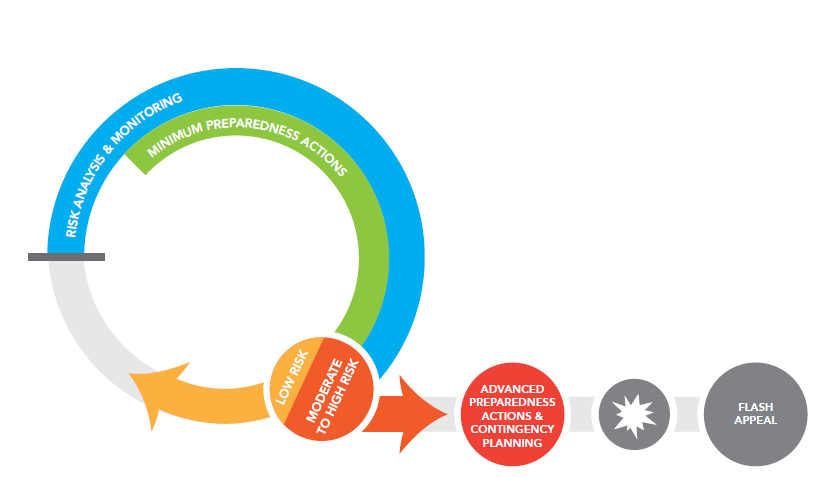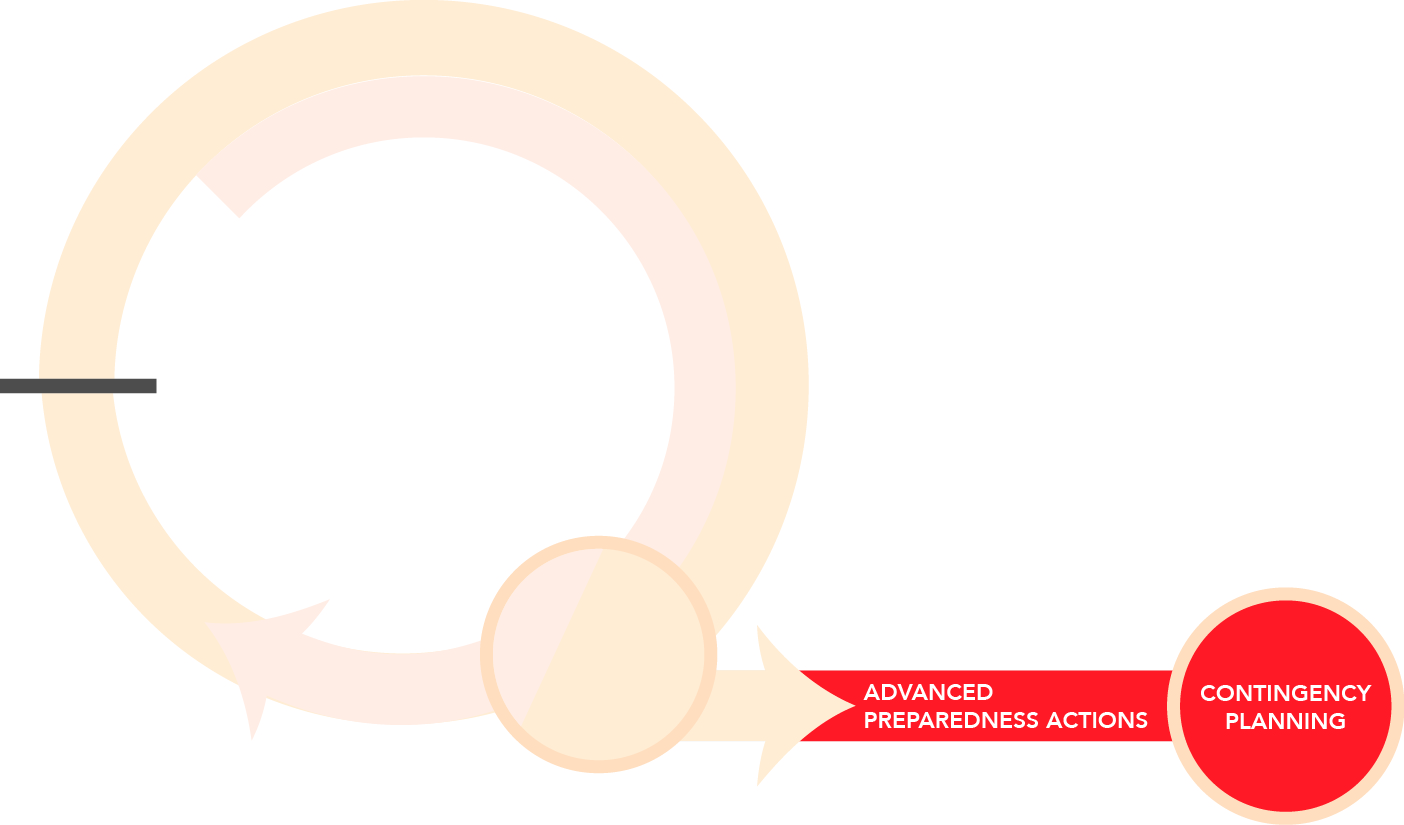Overview
Note. This guidance forms part of the Emergency Response Preparedness (ERP) approach. In its current form, it reflects the "BETA" version of the ERP, which the Inter-Agency Standing Committee (IASC) Task Team on Preparedness and Resilience released for field testing in 2015. The final version of the ERP may look different, once released.
"Contingency planning is a process, in anticipation of potential crises, of developing strategies, arrangements and procedures to address the humanitarian needs of those adversely affected by crises" (Richard Choularton, Contingency Planning and Humanitarian Action: A Review of Practice, HPN Network Paper No. 59, March 2007). A contingency plan (CP) sets out the initial response strategy and operational plan to meet critical humanitarian needs during the first three to four weeks of an emergency. It reflects the decisions taken by all partners involved in the planning process. If the emergency occurs, it should seamlessly transform into a Preliminary Response Plan (PRP), as foreseen by the IASC's Humanitarian Programme Cycle.
The ERP contingency planning process, usually led by the Resident Coordinator (RC) or Humanitarian Coordinator (HC) at country level, is primarily applicable to inter-agency preparedness for natural disasters and internal displacement (IDP) situations.
For potential refugee crises (where the identified emergency risk specifically relates to the possibility of a refugee emergency), the Preparedness Package for Refugee Emergencies (PPRE), which uses the same approach as the ERP, should be used as a toolkit and for guidance. The PPRE contingency planning guidance is specifically tailored to refugee crises. The UNHCR Representative in the country always leads inter-agency contingency planning for refugee situations, in support of the host Government.
Key principles of contingency planning
- Contingency planning should be simple and easy to carry out. The task should not be confined to specialists: all staff likely to be involved in the response should participate. Ownership and understanding are essential when it comes operationalizing a response.
- The contingency plan needs to be specific rather than generic. It is important to link the plan to risk analysis and monitoring, so that the plan is framed on the basis of specific information.
- Contingency plans should use resources efficiently, effectively and equitably to meet humanitarian needs appropriately.
- Contingency planning should be process-driven. Although written plans are important, in the absence of a sound process contingency planning may simply be ignored and end up shelved or filed away unused. The document itself is not the most important. It is the record of a decision-making process undertaken ahead of time that answers questions and assigns accountability.
- Contingency planning should be realistic. A realistic understanding of response capacity is essential for a realistic plan. In many contingency plans, it is assumed that sufficient response capacity exists or that it can swiftly be put in place. However, insufficient effort is made to determine what this entails. As a result, contingency plans can give the impression that a crisis can be managed when it is likely to far outstrip the response capacity that is available.

Relevance for emergency operations
The IASC system adopts a forward looking ‘no regrets' approach to ERP advanced preparedness actions (APAs) and contingency planning, especially when risk thresholds (identified by risk analysis) have been reached. When a risk is categorized as "medium" or higher (a risk ranking score of 8 or more), ERP APAs and contingency planning must be undertaken. See ERP risk analysis and monitoring.
The objectives of a contingency plan are:
- To foster a common understanding among all partners involved of the anticipated scope of the emergency, possible humanitarian needs, and the nature and scope of the planned operational response.
- To explain clearly the sector/cluster response strategy for addressing the imminent needs of the affected population in the first weeks of an emergency.
- To identify specific challenges and gaps in the potential response.
- To communicate anticipated funding requirements.
To support prompt drafting of a Preliminary Response Plan (PRP) if an emergency occurs.

Main guidance
Underlying process – how does this work?
The triggering and implementation of ERP contingency planning should be led by the RC or HC, with the participation of members of the UN Country Team (UNCT) or Humanitarian Country Team (HCT). Where the risk level remains ‘medium' or ‘high' for a longer period, or the hazard that instigated the response worsens, it is recommended that contingency plans should be regularly reviewed.
Step 1. ERP Advanced Preparedness Actions (see ERP Advanced Preparedness Actions)
Step 2. Developing a contingency plan
The UNCT or HCT should establish a work plan and timeline for development of the plan. Accountability and deadlines for completing various sections of the plan should be agreed and assigned. Given that the UNCT or HCT, under the leadership of the RC or HC, has overall responsibility for the contingency plan, regular consultation should take place and actions should be guided.
Step 3. Addressing preparedness gaps
Preparedness gaps that are identified during the planning process should be addressed. Again this should be undertaken in a systematic manner and accountability and deadlines should be agreed and assigned.
Step 4. Testing the contingency plan
A schedule for regular testing and reviewing of the plan should be agreed. It should be linked to risk monitoring. Tools such as simulations should be used to test the plan.
ERP contingency plan structure. (See also the attached ERP contingency plan template)
(a) Situation and risk analysis (including gender analysis). This section provides a summary of what is likely to happen, its likely impact, and the capacity to respond. It also contains the main planning assumptions used to develop the contingency plan.
(b) Response strategy. This section outlines what the plan hopes to achieve. Based on the situation and risk analysis, a response strategy is developed. The response strategy contains two main elements. First, objectives are set based on information from the risk analysis. Second, a response or interventions are developed to meet these objectives
(c) Operational delivery. While the response strategy defines objectives, this section defines how they will be achieved. Operational delivery defines appropriate interventions and how they will be implemented (for example, by using local NGOs in partnership with local government to distribute relief items), and the steps required (logistics and needs assessments, etc.). This section is presented in the form of cluster summary plans, which include an overview of the operational actions needed to meet cluster/sector objectives.
(d) Coordination and management arrangements. This section sets out the coordination and management structures that are needed to support the response.
(e) Operational support arrangements (common assessment/information management/ response monitoring). This section sets out arrangements for supporting operations. The specific need for operational support will become clear as a CP is developed.
(f) Preparedness gaps and actions. This section outlines the preparedness gaps identified during the planning process. Gaps identified should be reviewed and prioritized and responsibilities and timelines for actions to address the gaps should be assigned.
(g) Funding requirements. This section should contain two budgets: an indicative budget for the planned response; and a budget for preparedness actions. Preparing indicative budgets has several benefits. First, it gives both HQ and donors a clear indication of what support is likely to be required and the likely scale of the response being planned. Second, it ensures that, if a response is required, time is not lost issuing budgeted response plans.
Maintenance
The contingency planning process does not end with production of a CP. The plan must be reviewed and updated regularly. It is particularly important to review the plan thoroughly when a change in the situation is signalled by risk monitoring, or when the institutional environment alters (following a significant change in membership or leadership of the HCT, for example). Ongoing involvement in CP follow up should be included in the work plans of participating organizations and individuals.
Simple simulation exercises are valuable. They familiarize those who will take part in a humanitarian response with the coordination and response mechanisms envisaged in the plan. They also help to test planning assumptions and response systems. Simulations may be used as part of a regular schedule for reviewing and updating the contingency plan.
UNHCR’s role and accountabilities
As a member of the UNCT and HCT, UNHCR participates in ERP contingency planning for natural disaster and IDP situations, led by the RC or HC in the country. UNHCR may also lead the development of cluster plans, if the clusters it leads (Protection, Shelter, Camp Coordination and Camp Management) are foreseen by the CP in question and UNHCR's leadership is appropriate. (In natural disaster situations, IFRC leads shelter cluster activities, and IOM CCCM activities.) A Protection Cluster plan should always be included in ERP contingency plans.
ERP is primarily applicable to inter-agency preparedness for natural disasters and internal displacement (IDP) situations. For potential refugee crises (where the identified emergency risk specifically relates to the possibility of a refugee emergency), UNHCR leads preparedness efforts with partners and the Preparedness Package for Refugee Emergencies (PPRE), which uses the same approach as the ERP, should be used as a toolkit and for guidance. The PPRE includes specific guidance for inter-agency contingency planning in refugee crises.
Links
Main contacts
UNHCR Division for Emergency Security and Supply (DESS), Emergency Services. At: [email protected].
In this section:
Let us know what you think of the new site and help us improve your user experience….
Let us know what you think of the new site and help us improve your user experience….
